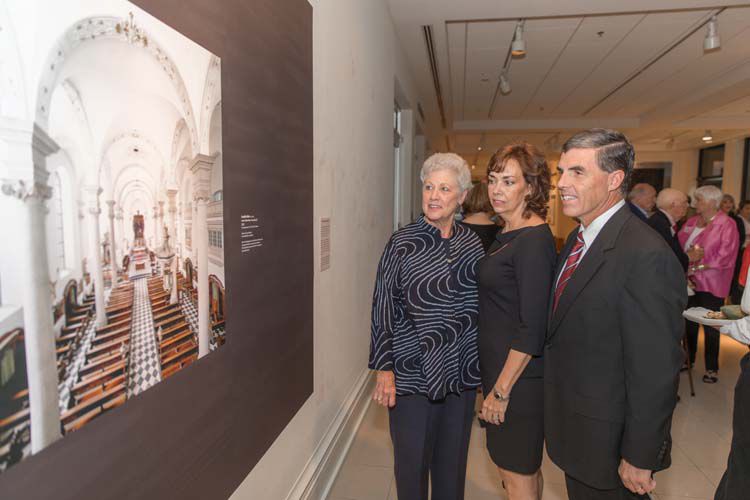At its annual dinner Friday, the Vero Beach Museum of Art’s Athena Society selected two artworks that it will purchase for the museum’s collection.
This year’s picks are “A Study for South of Scranton,” a 1930 oil on canvas by American Peter Blume, and “Sankt Maximilian Düsseldorf 1,” a 2012 photograph of a church interior by German Candida Höfer.
In total four pieces were offered to the Society for consideration. The two that didn’t make the cut were John Marin’s 1950 oil painting “New York Series: from Weehawken Heights,” and James Casebere’s 2009 color photograph, Landscape with Houses, #1.”
That’s good news for at least one Athena Society member. Previewing the works in the museum’s main hallway before the dinner, Georgia Welles remarked that she was partial to the Höfer, because she has always purchased contemporary art for her own collection.
Nevertheless, “I like to think about what the museum needs, and that is the Blume,” she added.
“But I’m not going to tell you what I’m going to vote for.”
What the heart wants versus what the head knows was, no doubt, the dilemma faced by many of the Society’s members, perhaps right up to the time they marked their ballots.
Currently numbering 89 household memberships (often composed of one couple per household), the Athena Society was formed in 2003 for the express purpose of buying desirable artworks for the museum’s permanent collection.
The group is composed of VBMA Chairman’s Club members ($1,500 per annum) who donate $5,000 extra per year to be a part of the Society. For this year’s selection, the Society collected almost half a million dollars to spend on works chosen for their consideration by the museum’s director, Brady Roberts.
As in past years, in early 2017 the hunting grounds for Athena Society offerings was New York City and its surfeit of retail galleries and art fairs.
“I went to the Winter Antiques Show in New York, and then returned to New York for the Armory Show with a half-dozen supporters of the museum,” Roberts said.
Both times, he visited Peter Blume’s “A Study for South of Scranton” at Debra Force Fine Art. That gallery specializes in American paintings, drawings and sculpture from the 19th and early 20th centuries.
The first time Roberts visited the gallery, the Blume was resting on a pedestal. The second time he and his group of VBMA patrons saw it, the painting was hung and well-lit. Roberts says that although the canvas is not large (its vertical format measures a tad over 28 x 20 inches), the strong composition and colors of the work have the power to pull the art lover in from a distance and keep her there.
After drinking their fill of “A Study of South Scranton,” Brady took the group to the Metropolitan Museum of Art to view the painting for which Blume’s study was a preparatory work. “South of Scranton” was added to the Metropolitan’s collection in 1942, 10 years after its creation date. The 56-x-66-inch painting is considered one of Blume’s masterpieces.
“Putting artworks in their proper context is what a curator is supposed to do,” says Roberts.
He makes clear that while the VBMA’s acquisition is called a “study,” it is just as completely thought out and executed a work as the Metropolitan’s Blume.
“A Study for South of Scranton” has the added benefit of having been included, along with the Metropolitan work, in a 2014 retrospective of Blume’s paintings at the Pennsylvania Academy of Fine Art.
That kind of high-profile exhibition history, as well its relationship to what might be called its larger companion, “South of Scranton,” adds cachet to the VBMA’s painting.
Peter Blume (1906-1992) was born in Russia and immigrated with his family to New York a few years later. As a teenager he trained at the now-defunct Beaux-Arts Institute of Design in Manhattan and the Art Students League. Before he was 20 he opened his own studio and was showing his work alongside the likes of Man Ray, Marsden Hartley, Charles Demuth and Charles Sheeler at the West 47th Street art gallery of modernist impresario Charles Daniel.
In the 1930s and ’40s Blume was recognized for the dreamlike quality of his paintings. Although he was never associated with any surrealist group, Blume made his fantasies concrete through his use of smoothly worked paint surfaces and convincingly rendered detail.
“South of Scranton” is a compilation of scenes that the artist encountered during a car trip from his home in Connecticut to Charleston, S.C., with stops in Scranton and Bethlehem, Pa., in between.
German artist Candida Höfer was born in 1944. She studied photography at the Kunstacademie Düsseldorf under the conceptual artists Bernd and Hilla Becher.
“Sankt Maximilian Düsseldorf 1” is a 71-x-67½-inch color photograph offered by the artist’s New York representative, Sean Kelly Gallery.
Because the artist prints her pictures as they are ordered, her photograph was represented for viewing by the Athena Society as a small reproduction printed on a large black rectangle affixed to the wall in the museum’s main hallway. A notice within the rectangle explained that large black area represented the size of the actual work.
Höfer is noted for her large-scale color photographs of the interiors of vast buildings such as churches, museums, libraries, hotels, opera houses and theaters.
Taken for a high vantage point, the symmetrically composed “Sankt Maximilian Düsseldorf 1” is an interior view of an 18th century church built by the Franciscans.
Seen through a central archway at the back of the nave, the photograph’s one-point perspective culminates in the altar painting at the front of the church. The viewer of this work, after taking in the sweeping sense of place and light in the white-washed interior, begins to settle down to read its tiniest details, courtesy of Hofer’s large-format camera.
All four of the artworks considered by the Athena Society will continue to be on display in the museum’s main hallway through the end of the April.

